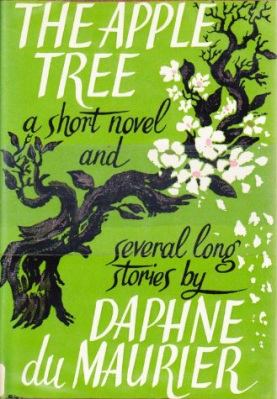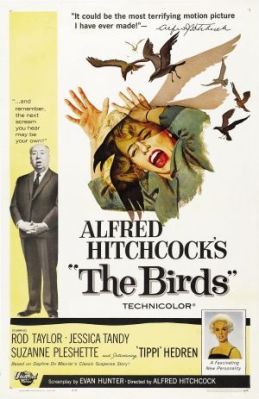
Daphne du Maurier’s “The Birds” opens with Nat Hocken, a farmhand, lamenting the overnight arrival of winter. Soon after, birds begin entering his home, attacking his family.
All of the birds in England seem to have gone insane — perhaps all of the birds in Europe, too, if the lack of radio communication is any indication. Nat and his family struggle to protect themselves over the next few days as large flocks of seagulls, finches, hawks, and other birds wreak havoc on their town. They lock themselves in the kitchen, simply waiting it out as the birds attack in waves.
First published in du Maurier’s 1952 collection The Apple Tree, “The Birds” was adapted for the screen by Evan Hunter in the early 1960s.
The result of Hunter’s screenplay was the famed Hitchcock film The Birds, released in 1963. (Hunter and Hitch has previously worked together, and Hitch personally selected the writer for this film.)
The story was also printed in Alfred Hitchcock’s Spellbinders in Suspense, a series of mysterious short shorties introduced by the director. I own a copy of this book, and re-read the short story just before my most recent re-watch of the film.
There are a number of substantial differences between Hitchcock’s film and du Maurier’s story.

The printed version is set in London, while the screen version takes place in California. The film opens in a pet shop, while the story opens with Nat’s observations of odd avian behavior, followed by the first attacks.
Additionally, the characters in the film are completely different from those in the story. The Hockens aren’t preserved from page to screen, replaced by lawyer Mitch (Rod Taylor) and media heiress Melanie (Tippi Hedren) as the film’s central characters. This actually works very well as a device to involve more of the town in the story — at one point, diners at a local restaurant accuse Melanie of bringing the evil to town.
Still, the general premise is the same for both the film and its source material: birds, for some reason, begin gathering in large, inter-species groups and attacking humans.

Though we don’t meet the Hocken family in Alfred Hitchcock’s telling of The Birds, some of the film’s most chilling scenes take place at the rural home of Mitch’s mother and a nearby farm, similar to the settings which exist in the story.
It was a great choice to keep some of the scenes of big action confined to a house. It lends a claustrophobic mood to the whole situation, and heightens the level of suspense even further.

The suspense of the story and that of the film also mirror each other in that there is a slow build. It’s even slower on the screen than on the page, and is incredibly successful in keeping either the reader’s or the viewer’s attention.
The film version of The Birds has never been claimed to be more than “loosely” based on Daphne du Maurier’s story, which accounts for the severity of the changes made. This is a great example of taking a short story and preserving its essence, but adapting it to make it more well-suited to the screen.
Film and print are very different mediums, after all, and not everything that is written can be translated directly into action with total success. When working from a short story, there’s plenty of room to add complexity and new dimensions to the tale, which is precisely the case here. The story is much more open-ended, and while I love a super-ambiguous ending, I like the way things are wrapped up in the film, too.
Both the story and Hitchcock’s film are suspenseful, tense, and well-crafted. The story is well worth reading, and the film – of course – is well worth watching.
Funny that with the number of times I’ve watched ‘The Birds’ and read up on Hitchcock, I’ve always assumed that du Maurier’s source material was a full-length novel, and not a short story. Always something to learn here at TMP!
LikeLike
It’s a sound assumption to make, since Hitchcock did adapt a couple of du Maurier’s full-length novels as well. This one’s nowhere near novel length, though — only about 30 pages long in the book I own, which has pretty large print!
LikeLike
fascinating and interesting comparison – I love analyses like this!
LikeLike
Thanks! :)
LikeLiked by 1 person